I have to fess up that I failed the Aston dress code miserably when I went to collect the DB9. A T-shirt emblazoned with the 1960s’ Ducati logo, jeans from a Third World tailor, and blue Fila driving shoes stamped with the prancing-horse brand of Aston’s Latin rival were hardly the appropriate uniform. To live up to fiction I should have really turned up in a tux, with a nine-millimetre Beretta pistol discreetly shoulder-holstered, a host of security-busting gadgets in one pocket, and a stash of high-quality condoms in the other. I would have introduced myself to the staff at Auckland’s Independent Prestige dealership as “Owen (pause for effect), Paul Owen.” And they doubtless would have doubled over with laughter at the improbability of it all.
Aston’s association with the Sean Connery version of James Bond endures despite Bond having been played by numerous other actors, and having been seen in lots of other cars since the DB5 first starred in Goldfinger. BMW even paid $US24 million in product placement fees to get Bond to climb aboard the wheel of a Z3 convertible for a few brief minutes in one flick (mind you, people should be paid to drive the worst Beemer of recent history). Yet, despite the evolution of the Bond character from MI6 man-of-the-world to corporate spy, it still seems most appropriate for him to drive an Aston Martin. Patriotic, even.
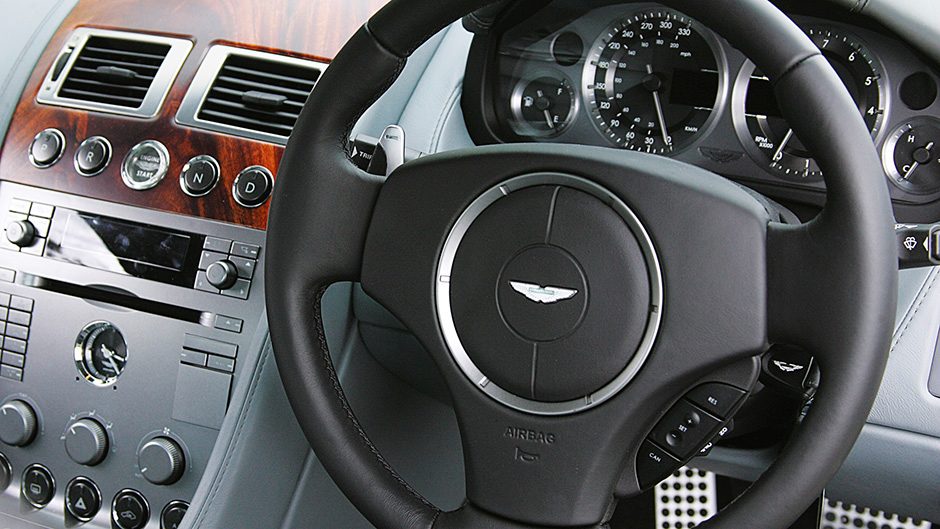
You’ll be pleased to know that Bond will be Aston-driven in the next mega-flick, and the DB9 will be his weapon-laden carriage. It’s all part of Aston Martin’s grand renaissance in the early 21st Century. Not only has funding been made available for better products and a new state-of-the-art manufacturing factory, but for appropriate product placement as well.
The last time I drove an Aston Martin was back in the bad old days for the brand. It was a DB7, made at a time when the company struggled to build and sell more than three cars a day. I had just stepped out of Jaguar’s then-new XK8, and couldn’t comprehend why anyone would stump up another 100 grand on the XJS-platform-sharing DB7. James Bond fantasies and a slightly prettier form could only carry a car so far. Especially when the asking price was $340,000.
Remember that figure, for the DB7’s replacement is some $20,000 less, and a vastly superior car despite the drop in price. There’s no real comparison between DBs Seven and Nine, except, perhaps, in their visual appeal. The DB7 was just as mouth-wateringly desirable in its looks as any Aston, even with the XJS platform dictating a short wheelbase and long overhangs. The DB9 maintains the classic coupé form that is instantly recognisable as a Desirable Brit, yet refines the look thanks to the freedom given to the car’s designers by Aston’s new VH (Vertical Horizontal) platform. This allowed initial designer, Ian Callum, to shorten the overhangs and extend the wheelbase of the DB9. Callum’s work was then completed by Henrik Fisher in the most satisfying way possible. If I’ve driven a better-looking car, I can’t remember it. Visions of this DB9 will probably flash in front of my eyes as I take my last breath. For no object has so commanded my attention like this before.
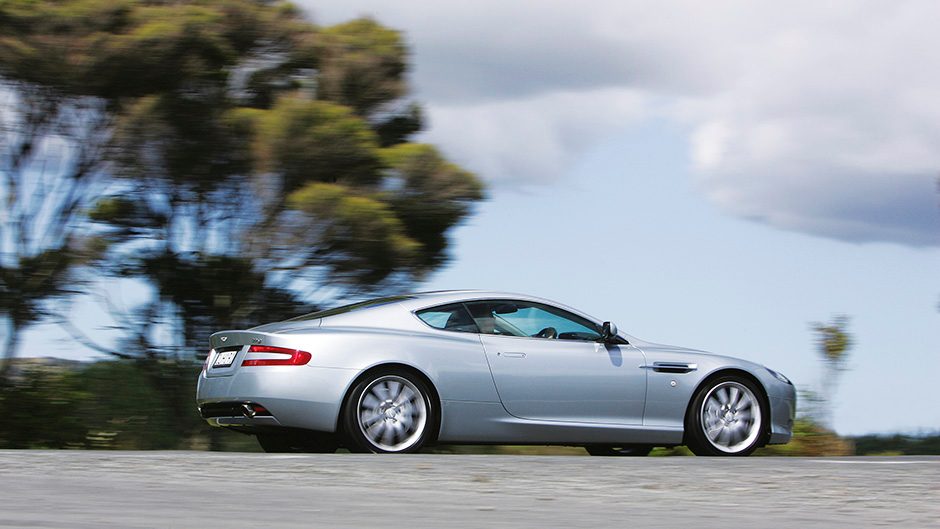
The DB7 also had this appeal, but lacked engineering substance beneath the sheet metal. Structurally, the DB9 is as technically advanced as the Seven was semi-obsolete. Borrowing the same technology that Jaguar used on the XJ saloon, the DB9 eschews steel in favour of lighter aluminium, magnesium and composite body materials. The underframe (platform) consists of alloy extrusions and pressings, fixed in place by rivets, then welded together for the life of the vehicle by special adhesives developed for the aerospace industry. The pressed aluminium body panels and roof are then glued onto the platform, this time with cold-cured adhesives for extra vibration damping instead of the high-tech hot curing that bonded the platform components.
The results are admirable, both in appearance and in performance. Despite the variety of materials used in the DB9’s body, the panel gaps are uniformly even – quite an accomplishment considering the use of composites for the front wings, engine bonnet and boot-lid. Then there’s the question of stiffness and the compromise that must be made for weight management. Any car maker can make a stiff car body, but few can achieve it without the mass of the vehicle blowing out to SUV proportions. With the DB9 body weighing 276.5kg, and requiring 27,645Nm to produce one degree of twist, Aston Martin has created a very stiff bone structure with little excess fat. By comparison, BMW’s 5 Series is currently considered the benchmark for steel body design. Although lighter than the DB9’s body by 13kg, the 5 Series isn’t nearly as stiff at 22,000Nm/degree of twist.
The benefits of that stiff, yet relatively light body can be felt as soon as you put the DB9 in motion. It sets up solid foundations for a virtuoso performance from the double-wishbone suspension, improves the power-to-weight ratio, and – potentially – offers better protection in a crash. Speaking of ‘moments like these…’, the DB9’s three-stage front crumple zone is a piece of work of which Volvo would be proud to claim ownership. Hang on: it actually is Volvo’s work, the Aston drawing on expertise from all over the Ford family of car brands. Volvo also contributed the sophisticated multiplex electronic modules for the Aston, while the inspiration to use a carbon-fibre driveshaft, running inside a rigidity-adding ‘torque tube’ between the front/mid-mounted engine and rear transaxle, could have come from the Mazda RX-8.
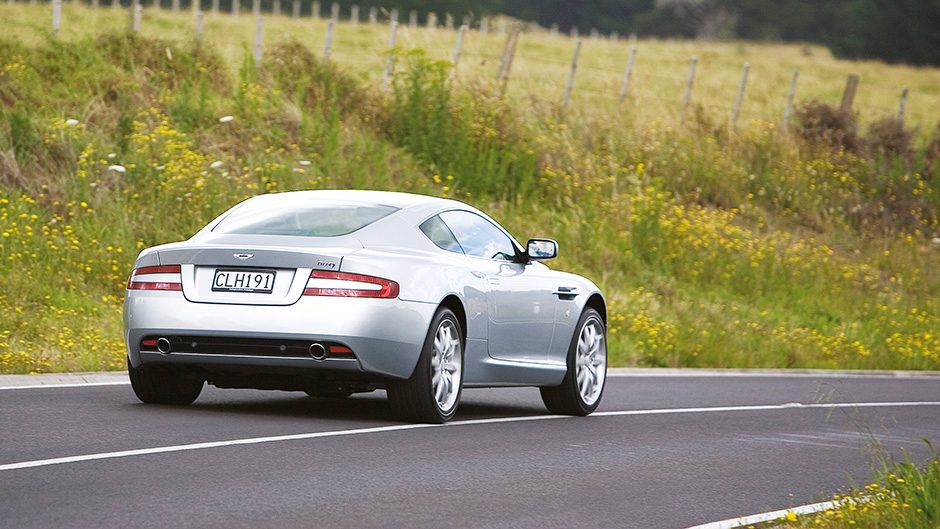
The siting of the 6.0 litre V12 far back in the engine bay, and the banishment of the ZF six-speed automatic transmission to just ahead of the rear wheels, demonstrates the careful attention to mass management in the DB9. Aston says the car has perfect 50:50 weight distribution; and our scales say it got real close at 52:48. The scales also reveal a fuelled-up weight figure of 1785kg, positively featherweight for a large luxury sports-coupé with a big lump of a V12 in its midst.
Pushing buttons is something the driver does a lot of in the DB9. To start the car, there’s a central engine-start button in the top row of powertrain controls on the centre console. Then you put the auto into ‘D’ through the press of another button to the right, as there’s no gear-lever, just four transmission buttons (five counting the ‘sport’ mode), and a pair of manual shift paddles on the steering wheel.
The V12 lights up with an ECU-programmed flourish of revs that add an air of expectation when you hit the start button. This is Aston’s third-generation V12 after the first appeared on the 1999 DB7 Vantage, and has seemingly been upgraded every second year since. We last encountered an Aston V12 back in the September, 2001, issue, with Ian Adcock’s report on the then-new Vanquish, powered by the second incarnation of the V12. Subsequently, Aston has extracted more power and torque from the double-six, and pruned the engine mass by 11kg in a programme of ongoing development. There’s no techno-wizardry in this V12, no variable-camshaft timing or induction plumbing sleight-of-hand; instead, there’s good old attention to cylinder-head flow, achieved through optimum camshaft grinds, and free-flowing exhaust and induction systems. You don’t miss VVT, VANOS, Variocam, or even a can of V, when driving the DB9. For the V12 is full of vim and vigour right from basement engine speeds, with 80 per cent of the 570Nm maximum torque figure clocked in by 1800rpm.
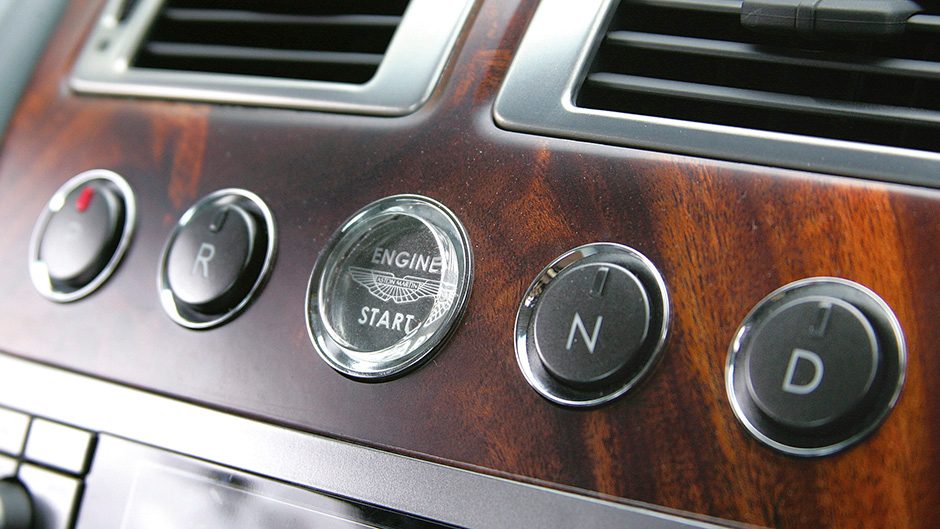
Coupled to the low mass of the vehicle, this accessible grunt gives the DB9 an ability to lunge away from other traffic at the lights on just a whiff of throttle. As you use no more than a fraction of the travel of the accelerator pedal, you could be mesmerised by the powertrain performance; however, it’s just a taste of better things to come. At 3500rpm, a flap opens in the exhaust system to let the V12 really sing. This occurs at the same time as the pressure waves generated by the V12’s new induction manifold (the major design change over the Vanquish version, along with lighter pistons, rods and crankshaft) start ramming more air into the combustion chambers. The result is a louder snarl accompanied by a strong lift in acceleration, and it’s similar to the effect of a variable-valve timing system changing configuration to optimise performance. The driver soon learns that the upper rev range of the V12 is where the engine really delivers – both for increased aural pleasure and performance. As the tacho needle does its unique arc anticlockwise past the 3500rpm mark, the V12 sings with siren-like intensity, and hurls the Aston forward like a jet on afterburner.
The ultra-competent ZF six-speed auto is a great aid for keeping the V12 at its throaty best, especially via the manual shift paddles on the steering wheel. These activate the manual mode as soon as they’re touched – a handy feature when the red mist descends over the driver’s eyes and horns grow from his/her temples.
The DB9’s stiff body pays plenty of dividends over our bumpy back roads, adding directness to the turn-in quality of the awesome steering, and ensuring most of the road blemishes get completely absorbed by the suspension. Unlike many European GTs, the Aston is totally unfazed by our lumpy, exaggerated-camber roadscape. Many’s the time this driver tensed up when approaching a big bump at speed, only to have the DB9 blot out the surface imperfection with the same disdain the ruling classes reserve for peasantry. It was as if the bump didn’t exist.
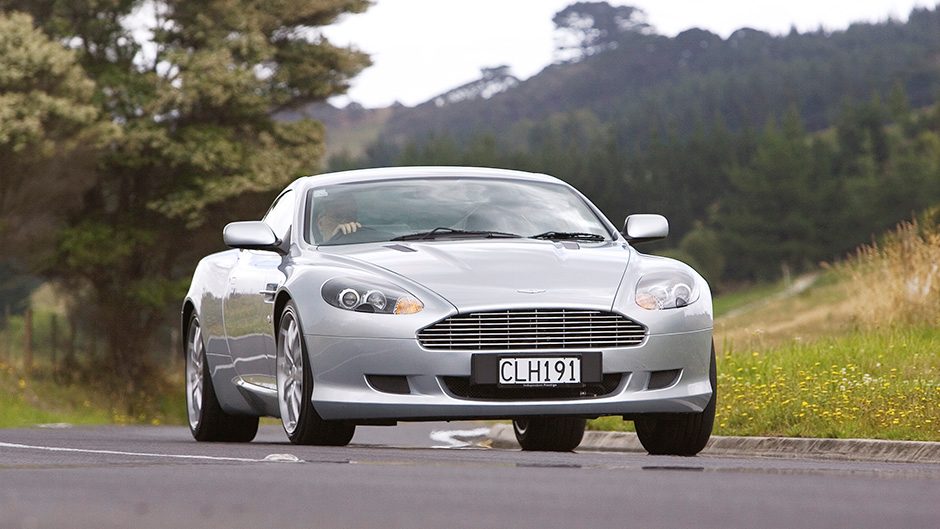
The suspension’s one trade-off is a firm ride at urban speeds, a necessary evil in a sports machine short on wheel travel. The DB9 is no worse than any HSV in this regard, but that firm ride at sub-70km/h speeds is all the more noticeable because the rest of the driving dynamics are so well polished. Highlights include the well-sorted steering, which offers feedback, consistency and agility in generous helpings, and the wealth of grip available, even with the electronic stability controls given a smoko break.
Meanwhile, Aston’s cabin is a beautifully crafted and desirably simplistic place to be. There’s no confusing control interfaces, and the only glitch here is that some of the script on the centre console requires a magnifying glass to read. And it all exudes such an air of quality, one wonders whether this car was really made in England. Then it happened: a moment that confirmed the British-ness of the DB9. As I pushed the ‘N’ button for neutral at a set of lights, it went all the way into the centre console. The incident made me smile with relief, because it proved that the DB9 isn’t yet the perfect Aston Martin. It’s merely the best car ever to wear a famous British badge.
| Model | 2005 Aston Martin DB9 |
| Price | $320,000 |
| Engine | 5935cc, V12, EFI, 336kW/570Nm |
| Drivetrain | 6-speed auto, RWD |
| 0-100km/h | 5.08sec |
| Weight | 1785kg |
This article first appeared in the February 2005 issue of NZ Autocar magazine.


